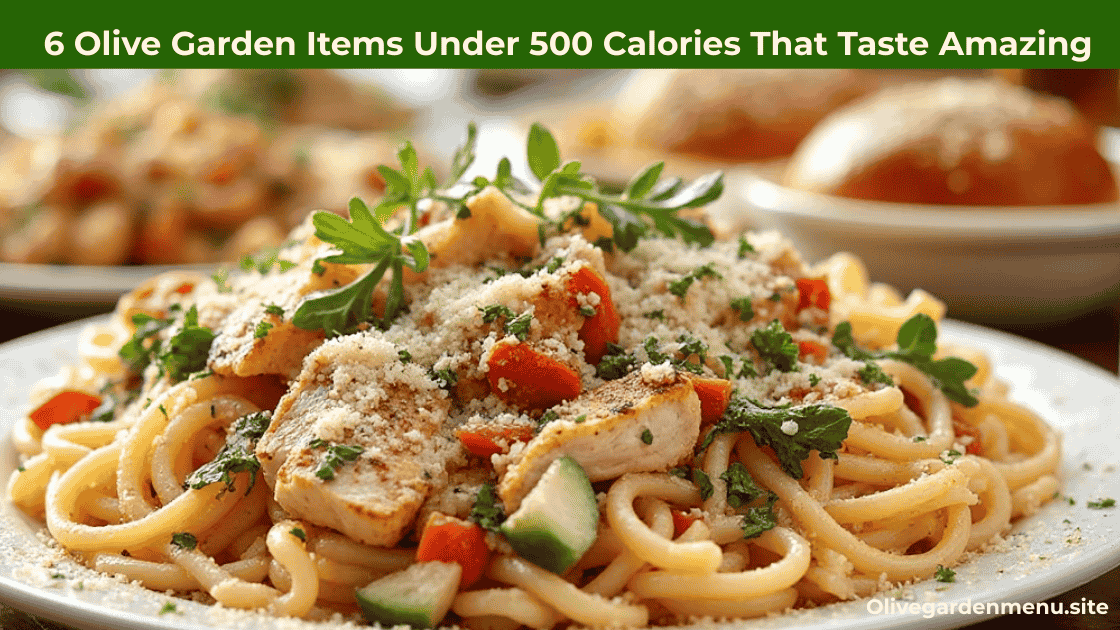If you’ve ever sat down at an Olive Garden table, you know the moment — warm, buttery breadsticks arrive, and that iconic Olive Garden House Salad is placed in front of you. Crisp lettuce, juicy Roma tomatoes, briny black olives, tangy pepperoncini, all coated in that rich yet zesty Italian salad dressing. It’s the kind of flavor that lingers in your memory long after the meal, which is why so many people search for the authentic Olive Garden Dressing Recipe to recreate that unforgettable taste at home.
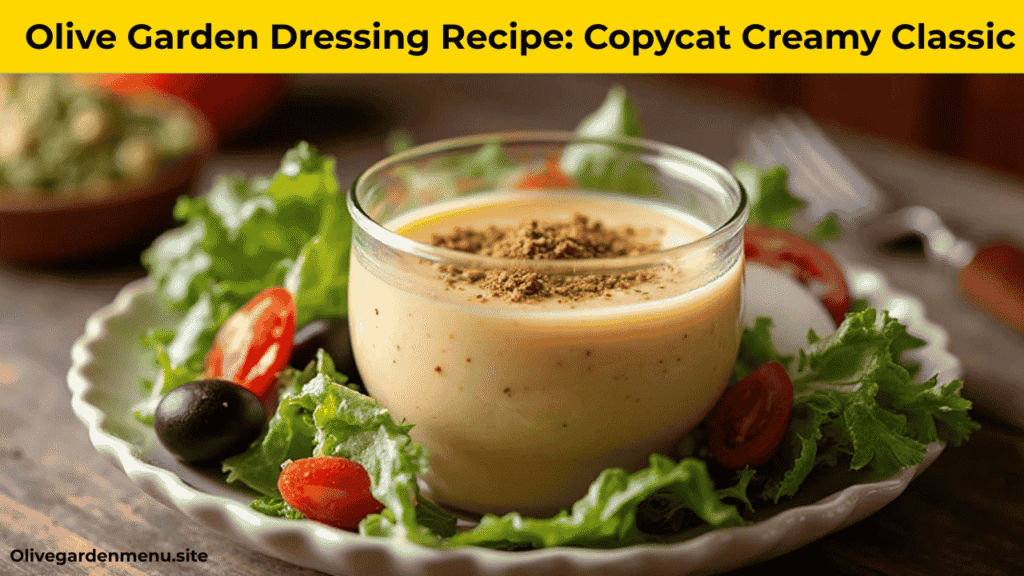
I remember trying to recreate it at home for the first time. I thought it would be simple — throw together a few pantry staples and call it a day. But no, Olive Garden’s dressing is balanced in a way that’s surprisingly hard to nail. Too much vinegar and it’s harsh. Too much mayo and it’s flat. It took me multiple tries, a lot of garlic powder, onion powder, and the perfect blend of Italian seasoning before I found my go-to copycat Olive Garden salad dressing recipe.
What Makes Olive Garden Salad Dressing So Popular
Why This Dressing is a Fan Favorite
The magic of Olive Garden Salad Dressing comes down to three things:
- Balanced flavor profile – Tangy from vinegar and lemon juice, creamy from mayo and Parmesan, with herbs that keep it bright and fresh.
- Versatility – It’s not just for salads. This dressing can be drizzled over grilled chicken, tossed with pasta for a cold salad, or even used as a breadstick dip.
- Nostalgia – For many of us, it’s tied to memories of family dinners, celebrations, or just that comforting lunch of Olive Garden soup, salad, and breadsticks.
It’s also customizable. Want it spicier? Add more red pepper flakes. Want a lighter version? Swap mayo for Greek yogurt. This adaptability keeps it relevant in home kitchens.
Ingredients for Olive Garden Salad Dressing
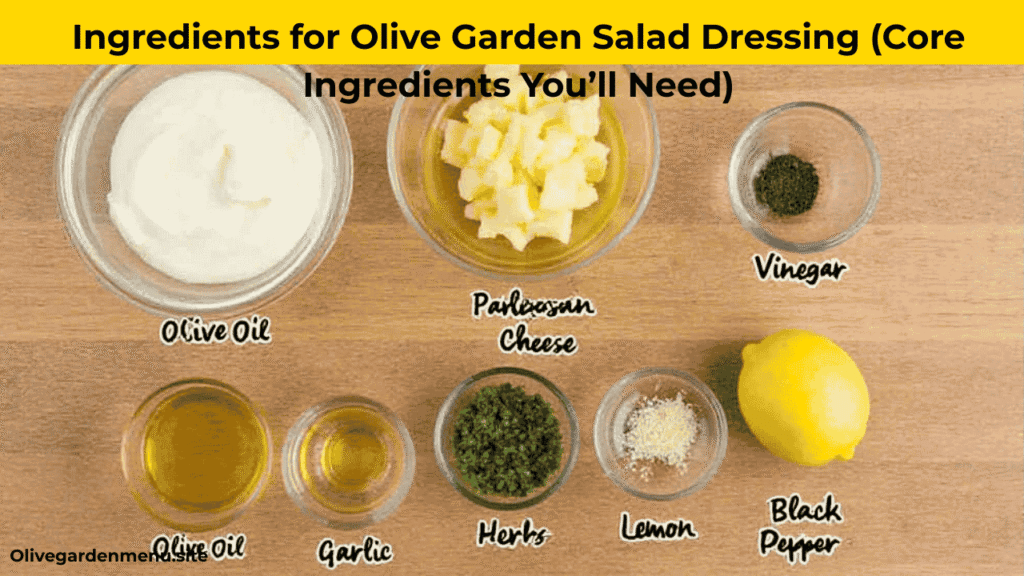
Core Ingredients You’ll Need
Here’s a table so you can see the exact ingredients that go into this Olive Garden dressing recipe and why each one matters:
| Ingredient | Purpose in Dressing | Notes / Variations |
| Olive Oil | Adds richness and body | Use extra virgin for depth of flavor |
| White Vinegar | Signature tang | Can swap with white wine vinegar for complexity |
| Parmesan Cheese | Savory, nutty creaminess | Freshly grated works best |
| Mayonnaise | Creamy texture | Swap with Greek yogurt for lighter version |
| Lemon Juice | Brightens flavors | Fresh juice preferred over bottled |
| Garlic Powder | Subtle savory depth | Adjust to taste |
| Onion Powder | Adds roundness | Balances sharpness from vinegar |
| Italian Seasoning | Herb blend | Use mix of oregano, basil, and parsley |
| Salt & Black Pepper | Balances and enhances flavor | Freshly ground pepper is ideal |
These core ingredients replicate the Olive Garden Parmesan dressing taste exactly — and they’re pantry-friendly, so you can make this any time.
Optional Add-Ins for Extra Flavor
Want to elevate your homemade Olive Garden salad dressing? Here are my go-to extras:
- Honey – Adds a hint of sweetness.
- Fresh basil or parsley – For a garden-fresh kick.
- Greek yogurt – Makes it tangier and lighter.
- White wine vinegar – Adds depth without overpowering.
- Red pepper flakes – For a zesty bite.
These tweaks can turn a classic Olive Garden dressing recipe into something uniquely yours while keeping it rooted in that beloved flavor.
Step-by-Step Guide to Making Olive Garden Salad Dressing at Home
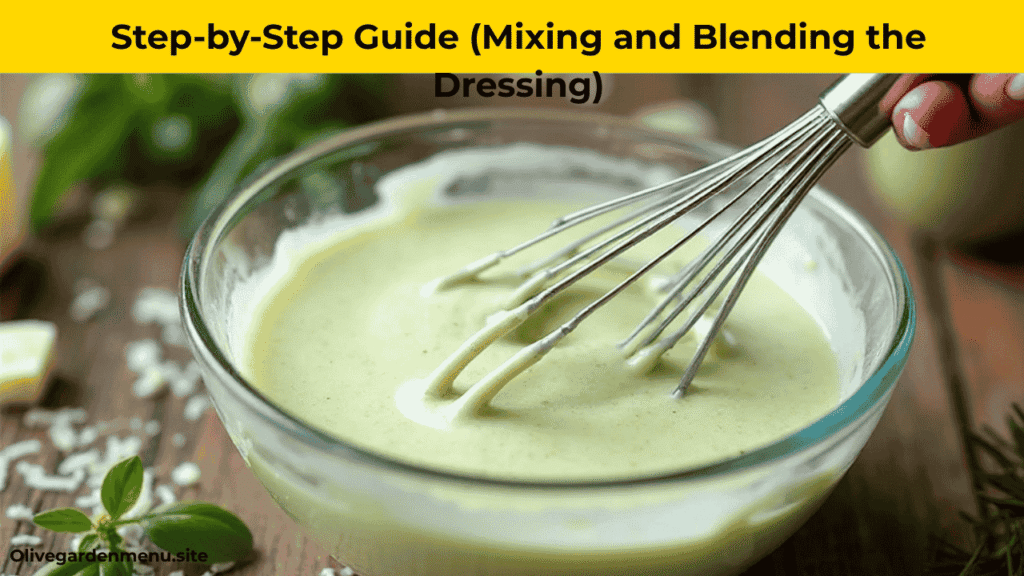
Making the perfect Olive Garden salad dressing at home isn’t just about tossing ingredients together — it’s about layering flavors so you get that signature creamy Italian taste in every bite. Here’s how I do it after years of trial, error, and taste-testing.
Preparing the Ingredients
Before you start, gather all your ingredients on the counter. This makes the process smoother and ensures you don’t miss anything important. For the core Olive Garden dressing recipe, you’ll need:
- Olive oil
- White vinegar or white wine vinegar
- Grated Parmesan cheese
- Mayonnaise or Greek yogurt (for a lighter version)
- Fresh lemon juice
- Garlic powder
- Onion powder
- Italian seasoning (oregano, basil, parsley)
- Salt and freshly ground black pepper
If you want a touch of sweetness, have some honey ready. For extra kick, keep red pepper flakes nearby. I like to pre-measure everything so when I start mixing, it feels effortless.
Mixing and Blending the Dressing
There are two main ways to mix your homemade Olive Garden salad dressing — by hand or using a blender.
- Blender Method – Add all ingredients to a high-speed blender and blend on medium speed for 20–30 seconds until fully emulsified. This gives you a smooth, restaurant-style texture that coats lettuce perfectly.
- Whisk Method – Add all ingredients to a medium mixing bowl and whisk vigorously until the oil, vinegar, and mayo are fully combined. This method gives the dressing a slightly rustic texture, which some people prefer.
No matter which method you choose, make sure to taste as you go. If the dressing is too tangy, add a touch more mayo or honey. If it’s too mild, increase the vinegar or lemon juice.
Adjusting Taste and Texture
One of the perks of making Olive Garden copycat recipes at home is that you control the flavor. Here’s how I adjust mine:
- Too thick? Add a teaspoon of water or extra olive oil and whisk again.
- Too thin? Blend in more Parmesan or a bit of mayo to thicken it up.
- Not tangy enough? Add a splash of white wine vinegar or more lemon juice.
- Lacking flavor? Sprinkle in extra garlic powder, onion powder, or Italian seasoning.
I also let the dressing chill in the fridge for at least 30 minutes before serving. This resting time lets the flavors meld, giving you that signature Olive Garden Parmesan dressing taste.
Best Vegetables for an Authentic Olive Garden Salad
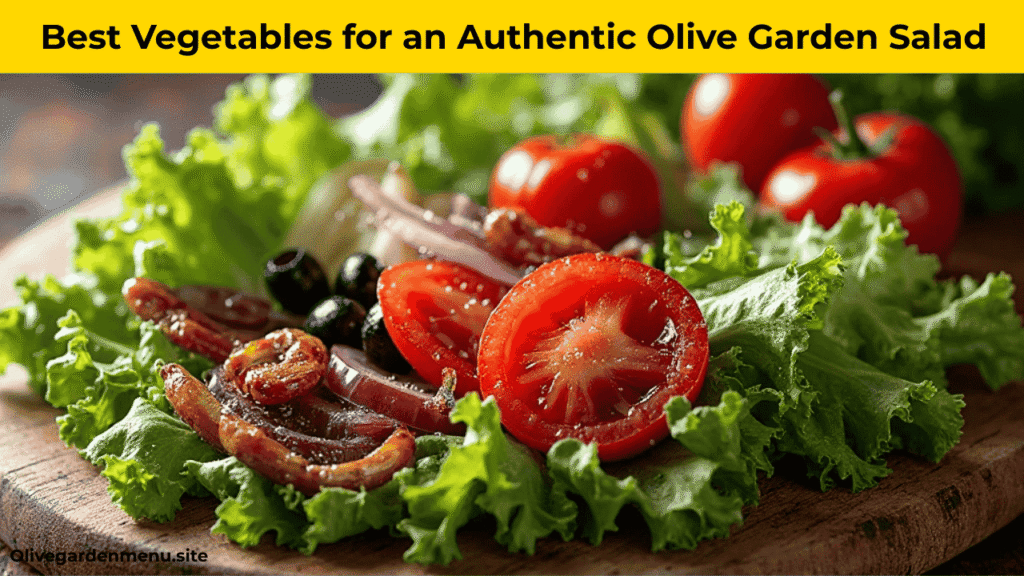
The dressing is important, but the Olive Garden salad ingredients themselves are what make the whole dish pop. When paired with the right veggies, your salad will taste just like it came out of the restaurant kitchen.
Fresh Produce Recommendations
For a true Olive Garden House Salad, here’s my go-to list of vegetables and toppings:
- Crisp iceberg lettuce (the base for that signature crunch)
- Romaine lettuce for texture variety
- Roma tomatoes for sweetness and juiciness
- Sliced red onions for mild sharpness
- Black olives for briny flavor
- Pepperoncini peppers for tangy heat
- Shaved carrots for color and crunch
- Freshly grated Parmesan for richness
- Olive Garden garlic croutons to tie it all together
These ingredients are non-negotiable if you want the full restaurant experience at home.
How to Prep and Store Vegetables
Freshness is everything when it comes to Olive Garden side salads. Here’s how I prep mine:
- Wash thoroughly – Use cold water to rinse away dirt and bacteria.
- Dry completely – A salad spinner is perfect for ensuring dressing clings to the leaves.
- Chop just before serving – This keeps veggies crisp.
- Store separately – Keep lettuce, tomatoes, and other wet ingredients in different containers until ready to assemble.
I like to store my greens in a large zip-top bag with a dry paper towel inside to absorb moisture. This keeps them fresh for 3–4 days. Then, when I’m ready to serve, I simply assemble the vegetables, toss with the Olive Garden creamy Italian dressing, and top with croutons and Parmesan.
Serving Ideas for Olive Garden Salad Dressing
There’s no denying that Olive Garden salad dressing shines in the classic Olive Garden House Salad, but it’s far more versatile than most people realize. Over the years, I’ve used it in so many creative ways — from light lunches to indulgent dinners — and it never fails to impress.
Salads That Pair Perfectly
Here are some salad ideas where this creamy Italian dressing truly comes alive:
- Classic Olive Garden Salad and Breadsticks – Crisp iceberg lettuce, Roma tomatoes, black olives, pepperoncini, garlic croutons, and a generous drizzle of dressing.
- Mediterranean Pasta Salad – Rotini pasta with cucumbers, tomatoes, olives, and feta, tossed in homemade Olive Garden salad dressing.
- Grilled Chicken Salad – Sliced Olive Garden chicken Romano or chicken Marsala over mixed greens, finished with the dressing for a tangy kick.
- Antipasto Salad – Salami, provolone, artichoke hearts, and roasted red peppers with the dressing as the perfect Italian vinaigrette.
- Garden Veggie Salad – A mix of fresh seasonal vegetables like zucchini, asparagus, and peppers, all tied together with a splash of zesty Italian dressing.
Other Dishes to Use This Dressing On
Don’t limit your Olive Garden copycat recipe to just salads. Here are some other ways I’ve enjoyed it:
- Pasta Dishes – Toss cold pasta with vegetables and dressing for a refreshing summer side.
- Marinade for Chicken or Shrimp – The tangy vinegar and herbs make it an ideal quick marinade.
- Dip for Olive Garden Breadsticks – A creamy, herby alternative to Alfredo sauce.
- Sandwich Spread – Swap mayo for Olive Garden Parmesan dressing in subs and wraps.
- Roasted Vegetables – Drizzle over warm roasted veggies like carrots, broccoli, or Brussels sprouts.
Substitutions and Variations
One of the best things about making Olive Garden dressing at home is how easy it is to customize it. Whether you have dietary restrictions or you’re just experimenting, there’s always a way to make it work.
Dairy-Free and Vegan Alternatives
If you want a vegan Olive Garden salad dressing, you can still capture the flavor without the dairy:
- Swap Parmesan cheese for nutritional yeast or a dairy-free Parmesan alternative.
- Use vegan mayonnaise or olive oil as your creamy base.
- Make sure your Italian seasoning doesn’t contain hidden dairy (some blends do).
- For extra creaminess, blend in soaked cashews instead of cheese.
These swaps keep all the tang and herbiness while making it completely plant-based.
Lower-Calorie Options
You can also make a lighter version of Olive Garden creamy Italian dressing without losing the flavor:
- Replace mayonnaise with nonfat Greek yogurt.
- Use less oil and add a splash of water to thin it.
- Increase lemon juice and vinegar for more brightness without extra calories.
- Cut back on cheese or use a light Parmesan blend.
I’ve used these tricks when making large batches for family gatherings, and even the most loyal Olive Garden salad fans couldn’t tell the difference.
Storage and Shelf Life of Homemade Olive Garden Salad Dressing
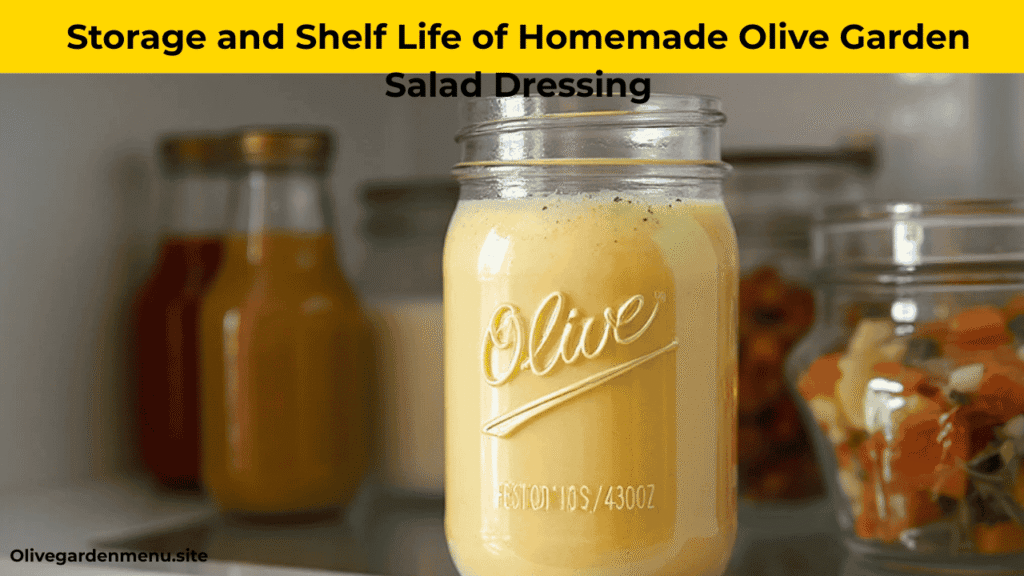
Proper storage techniques are essential for maintaining the quality, safety, and flavor of your homemade Italian vinaigrette. Unlike commercial dressings with preservatives, homemade versions require more careful handling to ensure they stay fresh and delicious. Understanding how to store this copycat recipe properly will help you enjoy restaurant-quality dressing for weeks.
Refrigeration Guidelines
Store your homemade Olive Garden salad dressing in an airtight container in the refrigerator immediately after preparation. Glass containers work best because they don’t absorb odors or flavors, and mason jars are particularly convenient because you can mix, store, and pour from the same container. The dressing will stay fresh for up to two weeks when properly refrigerated.
Always use clean utensils when portioning out the dressing to avoid introducing bacteria that could cause spoilage. The mayonnaise base makes this dressing more perishable than oil-and-vinegar only dressings, so refrigeration is non-negotiable. Never leave it at room temperature for more than two hours, especially during warm weather.
The dressing may thicken considerably when chilled, which is completely normal. Simply let it sit at room temperature for 10-15 minutes before using, or give it a quick stir to restore the proper consistency. Some separation is also normal – just whisk or shake gently before each use.
Label your container with the preparation date so you can track freshness. If you’re making large batches for meal prep, consider dividing the dressing into smaller portions to minimize exposure to air and contamination each time you use it.
Signs Your Dressing Has Gone Bad
Learning to identify spoilage signs helps ensure food safety and prevents waste. Fresh homemade Olive Garden salad dressing should have a creamy, uniform color and smooth texture. If you notice any mold growth, unusual discoloration, or separation that won’t recombine with stirring, it’s time to discard the dressing.
Smell is another reliable indicator of freshness. The dressing should have a pleasant, herb-forward aroma with notes of garlic and Italian seasoning. Any sour, rancid, or off odors indicate spoilage, even if the dressing looks normal. Trust your nose – if something smells wrong, don’t risk it.
Texture changes can also signal problems. While some thickening in the refrigerator is normal, if the dressing becomes slimy, excessively watery, or develops an unusual consistency that doesn’t improve with stirring, it’s likely spoiled. The mayonnaise base can break down over time, especially if exposed to temperature fluctuations.
Taste is the final test, but only if the dressing passes the visual and smell tests first. Fresh dressing should taste balanced with bright herb flavors. Any bitter, sour, or unpleasant flavors indicate it’s time to make a fresh batch.
Nutritional Information
Here’s an approximate breakdown of the nutritional values for a 2-tablespoon serving of homemade Olive Garden Salad Dressing. Keep in mind that exact values will vary depending on the brand of ingredients you use.
| Nutrient | Amount per 2 Tbsp |
| Calories | 80–90 kcal |
| Total Fat | 8–9 g |
| Saturated Fat | 1–1.5 g |
| Cholesterol | 0–5 mg |
| Sodium | 320–350 mg |
| Total Carbohydrates | 2–3 g |
| Dietary Fiber | 0 g |
| Sugars | 1–2 g |
| Protein | 0–1 g |
Note: Using reduced-fat mayonnaise or a lower-sodium Italian seasoning mix can significantly decrease the fat and sodium content without compromising flavor.
Final Thoughts
Making Olive Garden Salad Dressing at home not only saves money but also gives you full control over the flavor, texture, and nutritional profile. Whether you stick to the classic recipe or create your own variations, this dressing can instantly elevate any salad or even double as a zesty marinade. With fresh ingredients, proper storage, and a little creativity, you can enjoy this iconic flavor anytime without needing to step foot in a restaurant.
FAQs
What ingredients are in Olive Garden Salad Dressing?
The original Olive Garden Salad Dressing contains a blend of vegetable oil, vinegar, eggs, Romano cheese, garlic, sugar, salt, and a mix of Italian herbs and spices. The homemade version can be customized with fresh garlic, Parmesan cheese, or even a hint of lemon juice for extra tang.
Can you buy Olive Garden Salad Dressing in stores?
Yes, Olive Garden Salad Dressing is widely available in most U.S. grocery stores, big-box retailers like Walmart and Target, and online through Amazon. You can find it in both the original and light versions.
How should I store leftover Olive Garden Salad Dressing?
Store homemade dressing in an airtight container or glass jar in the refrigerator. It’s best consumed within 7–10 days for maximum freshness. Shake or stir before serving to recombine ingredients.
Is Olive Garden Salad Dressing gluten-free?
The bottled Olive Garden dressing sold in stores is labeled gluten-free. For homemade versions, ensure that all your seasonings, vinegar, and mayonnaise are certified gluten-free to avoid cross-contamination.
Can Olive Garden Salad Dressing be made ahead or frozen?
Yes, you can make it up to a week in advance and store it in the fridge. Freezing is not recommended because the emulsion can separate, affecting both texture and flavor.


